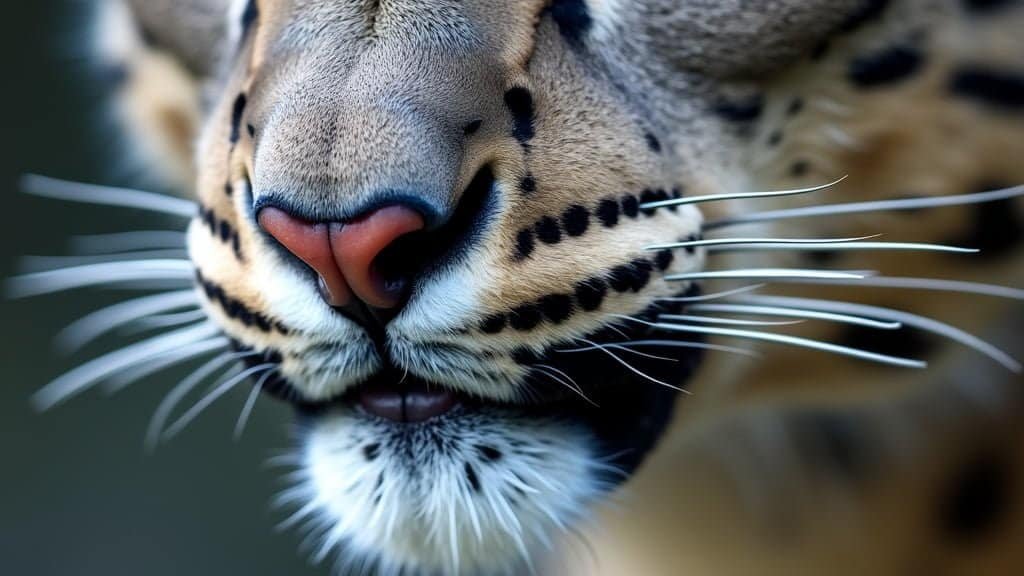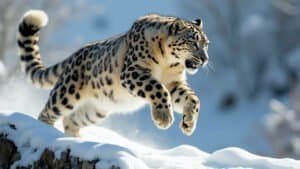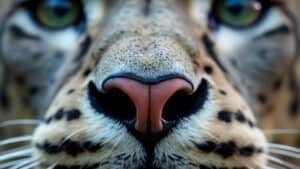Introduction
Snow leopards, known for their elusive nature and striking beauty, rely on their highly sensitive whiskers for survival in the rugged mountainous terrains they call home
This article delves into the intricate structure and remarkable sensitivity of snow leopard whiskers, comparing them to those of other big cats. We will explore how these whiskers detect environmental changes, assist in navigation, and play a crucial role in hunting
Additionally, we will examine the importance of whiskers in social behaviors and communication among snow leopards
Structure and Sensitivity of Snow Leopard Whiskers
Snow leopards possess some of the most highly specialized sensory adaptations among big cats, with their whiskers playing a critical role
These whiskers, or vibrissae, are not just ordinary hair but sophisticated sensory tools that enhance the snow leopard’s ability to perceive its environment. Understanding the structure and sensitivity of these whiskers provides insight into their essential functions in the life of a snow leopard
Anatomy of Whiskers
Snow leopard whiskers are deeply embedded in the skin, extending to the muscle and nerve endings. Each whisker is connected to a complex network of nerves and blood vessels, known as the follicle-sinus complex
This structure allows whiskers to detect minute changes in their environment. The average length of these whiskers can range from 3 to 5 inches, allowing them to protrude well beyond the fur and offer a tactile sense of the surroundings
The follicles of these whiskers are richly supplied with blood, ensuring that the slightest vibration or movement is transmitted as a signal to the brain. This ability to detect even the faintest touch is crucial for navigating the rugged and often perilous terrain of the snow leopard’s habitat
Comparison with Other Big Cats
While all big cats have whiskers, the snow leopard’s are particularly adapted to its mountainous environment
Studies show that the sensitivity of snow leopard whiskers surpasses that of lions and tigers, which inhabit less variable and extreme environments. This heightened sensitivity is necessary for detecting the subtle changes in the snow-covered terrain and for hunting elusive prey
For instance, the larger size and greater density of the whisker pads in snow leopards compared to other big cats suggest an evolutionary adaptation for enhanced sensory input
The snow leopard’s whiskers are not only longer but also more densely packed with sensory cells, making them exceptionally responsive
Sensory Receptors in Whiskers
The whiskers of a snow leopard are embedded with sensory receptors called Merkel cells and lamellar corpuscles
Merkel cells are responsible for detecting light touch, while lamellar corpuscles respond to deep pressure and vibration. This dual sensory system allows the snow leopard to receive a wide range of tactile information from its surroundings
Research indicates that these receptors can pick up on minute vibrations, such as those caused by wind or the movements of prey. This capability is particularly beneficial during hunting, as it enables the snow leopard to sense the presence and movements of prey even in low visibility conditions. Additionally, these sensory inputs help snow leopards maintain balance and agility on steep and rocky surfaces
In a study published in the “Journal of Mammalogy” in 2017, scientists found that the density of these sensory receptors is significantly higher in snow leopards than in other felids. This adaptation likely evolved to help them thrive in their specific ecological niche
The remarkable structure and sensitivity of snow leopard whiskers underscore their importance in survival
These whiskers are not just physical features but sophisticated sensory tools that provide critical information about the environment, enhancing the snow leopard’s ability to hunt, navigate, and interact within its harsh habitat
Role of Whiskers in Environmental Detection
Snow leopards rely heavily on their whiskers to navigate and survive in their rugged and often treacherous habitats. These specialized hairs provide crucial environmental information, enabling snow leopards to detect changes in their surroundings and move with precision and confidence
Detecting Changes in Terrain
The mountainous terrain inhabited by snow leopards is full of steep cliffs, rocky outcrops, and deep snow. Whiskers play a vital role in helping these big cats detect and adapt to these challenging conditions
By brushing against surfaces, whiskers can sense the texture and stability of the ground, allowing the snow leopard to avoid dangerous areas and find safe paths
Studies have shown that whiskers can detect slight variations in surface texture and temperature, providing snow leopards with detailed information about their immediate environment. This sensory input is especially important when snow leopards are moving in low light or poor visibility conditions, where visual cues are limited
Navigating Snowy Environments
Snow presents a unique set of challenges, as it can obscure the underlying terrain and make movement difficult. Snow leopards use their whiskers to gauge the depth and consistency of snow, helping them to avoid deep drifts that could slow them down or pose a risk of falling
In a study conducted by the Wildlife Conservation Society in 2018, researchers observed snow leopards using their whiskers to assess snow conditions before making leaps or climbing. This behavior indicates that whiskers are integral to their ability to move efficiently and safely in their snowy habitats
Whiskers also help snow leopards detect hidden obstacles beneath the snow, such as rocks or branches, that could impede their movement or cause injury. This capability is crucial for maintaining their agility and speed while traversing their mountainous territories
Sensing Weather Conditions
Weather conditions in the high-altitude regions where snow leopards live can change rapidly, with sudden snowstorms and strong winds posing significant challenges. Whiskers are sensitive to changes in air currents and pressure, helping snow leopards detect and respond to incoming weather changes
By sensing wind direction and speed, snow leopards can adjust their movements to stay downwind of prey, improving their chances of a successful hunt. Additionally, detecting changes in air pressure can alert them to incoming storms, prompting them to seek shelter or adjust their location
Research published in “Animal Behavior” in 2019 highlights the importance of whiskers in detecting environmental changes, noting that snow leopards with damaged or missing whiskers exhibited more cautious and less efficient movement patterns. This finding underscores the critical role whiskers play in the day-to-day survival of these elusive predators
Importance of Whiskers in Hunting
Snow leopards are apex predators, relying on their keen senses to hunt effectively in the challenging terrains of their mountainous habitats. Among these senses, whiskers play a crucial role in detecting and capturing prey, particularly in conditions where visibility is low
Locating Prey
The whiskers of a snow leopard are highly sensitive to vibrations and movements, allowing them to detect the presence of prey even when it is not visible. These tactile hairs can pick up on subtle changes in air currents caused by the movement of potential prey animals, such as ibex or blue sheep, which are common in the snow leopard’s diet
By extending their whiskers forward, snow leopards can scan their immediate environment for signs of life
This ability is particularly useful in dense vegetation or rocky areas where prey might be hiding. The information gathered by the whiskers helps the snow leopard to pinpoint the location of prey, reducing the need for visual confirmation and increasing hunting efficiency
Hunting in Low Light Conditions
Snow leopards are primarily crepuscular, meaning they are most active during dawn and dusk when light levels are low
In these conditions, their whiskers become an invaluable asset. The tactile feedback provided by the whiskers allows snow leopards to navigate and hunt effectively without relying solely on their eyesight
Studies have shown that snow leopards with intact whiskers are more successful hunters than those with damaged whiskers. This is because the whiskers help them detect the slightest movements of prey in low-light conditions, such as rustling leaves or faint footsteps, which might otherwise go unnoticed
A study conducted by the Snow Leopard Trust in 2020 found that snow leopards with impaired whiskers showed a significant decrease in hunting success, underscoring the importance of these sensory organs in their hunting strategy
Ambush Techniques
Snow leopards are known for their stealthy ambush techniques, often lying in wait for hours before launching a surprise attack on their prey
Whiskers play a critical role in these ambushes by helping the snow leopard remain undetected while it stalks its prey. The tactile feedback from the whiskers allows the snow leopard to move silently and avoid obstacles that might give away its position
When preparing to pounce, a snow leopard will often use its whiskers to gauge the distance to its prey, ensuring a precise and powerful strike. This level of sensory input is vital for the success of their ambush, as even a slight miscalculation can result in a missed opportunity
Research published in “Frontiers in Ecology and Evolution” in 2021 highlighted the role of whiskers in the predatory behavior of snow leopards, noting that these cats rely heavily on tactile information to execute their ambushes with precision
Whiskers and Social Behavior
While snow leopards are primarily solitary animals, their whiskers play a significant role in the rare social interactions they do have. These interactions, often involving communication, territory marking, and mating, are crucial for the survival and continuation of the species
Communication Among Snow Leopards
Whiskers are not only sensory tools but also means of communication. When snow leopards meet, they often engage in behaviors that involve their whiskers, such as face rubbing or mutual grooming
These actions are thought to facilitate social bonding and convey information about each individual’s identity, health, and reproductive status
In face-to-face encounters, whiskers help snow leopards interpret subtle social cues. By touching whiskers or faces, they can exchange information about each other. This behavior is particularly important during mating seasons, where understanding a potential mate’s readiness and willingness is essential for successful reproduction
Whisker Role in Territory Marking
Snow leopards are territorial animals, and they use scent marking to establish and communicate the boundaries of their territory
Whiskers aid in this process by providing tactile information about the surfaces they mark. By brushing their whiskers against rocks, trees, and other objects, snow leopards can better gauge the texture and location of potential marking sites
This tactile feedback ensures that their scent markings are placed in optimal locations where they are likely to be detected by other snow leopards. Properly placed scent marks help maintain territory boundaries and reduce the likelihood of conflicts with other snow leopards
Social Interactions and Whiskers
In the rare instances when snow leopards interact socially, such as during mating or between mothers and cubs, whiskers play an essential role. For example, mothers use their whiskers to guide and groom their cubs, helping them learn about their environment and develop crucial survival skills
During mating rituals, whiskers help snow leopards navigate the complex social dynamics involved. By sensing the subtle movements and positions of their partners, snow leopards can engage in more effective and less confrontational interactions
A study published in “Behavioral Ecology” in 2019 found that whisker-mediated behaviors are critical for successful social interactions among snow leopards. The research indicated that snow leopards with damaged or missing whiskers were less effective in social communication and exhibited higher levels of stress during encounters with other snow leopards
Conclusion
Snow leopards, with their striking presence in some of the harshest environments on Earth, rely heavily on their highly sensitive whiskers for survival
These whiskers serve multiple crucial roles, from detecting minute environmental changes to navigating through snowy terrains and sensing weather conditions. Their structure, rich with sensory receptors, provides an acute sense of touch that aids in hunting, especially in low-light conditions, ensuring efficient detection and capture of prey
Moreover, whiskers facilitate vital social interactions, assisting in communication, territory marking, and mating behaviors. They help snow leopards maintain social bonds and reduce conflicts within their territories. The intricate design and exceptional sensitivity of snow leopard whiskers highlight their importance in the animal’s daily life and overall survival strategy
Understanding the multifaceted roles of whiskers offers deeper insight into the remarkable adaptations of snow leopards, emphasizing the delicate balance of their ecological niche. These sensory tools are indispensable, showcasing nature’s ingenuity in equipping these magnificent cats to thrive in their demanding habitats













